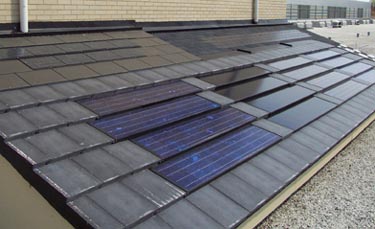Rooftop PV Data for Better Energy Prediction ModelsFrom NIST Tech Beat: June 22, 2006
Contact: John Blair (301) 975-4261
New generations of photovoltaic (PV) roofing products utilize designs that allow them to be integral parts of the roof, providing both electricity and shelter from the elements. But how effective would they be on your roof? This month the National Institute of Standards and Technology (NIST) began a 15-month research project to help resolve such basic costs concerns. At its new Roof Photovoltaic Test Facility, NIST is monitoring the electrical performance and thermal performance of seven different residential systems designed for sloped roofs and two commercial building units designed for flat, industrial roofs. The data will be used to evaluate and improve computer algorithms for software simulation programs that predict the installed energy production of photovoltaic roof installations. The test photovoltaic systems are blended into concrete tile, slate and asphalt shingle roofs for residential applications and in raised, unframed modules for commercial applications. Each of the nine photovoltaic systems fall within the three general categories of photovoltaic cell technology—single crystalline, polycrystalline and amorphous silicon—with each unit representing different manufacturing processes, materials and design features.Current, voltage and power output are sampled four times a minute for each test specimen. Ambient temperature, wind speed and the temperature of the test specimens also are measured at numerous locations because the operating temperature of photovoltaic modules affects the conversion efficiency of the units. Finally, the researchers are taking solar radiation measurements at the various planes of the installed roofing projects. Comparative analysis of the solar radiation data will allow NIST researchers to determine the accuracy of solar radiation models that take the horizontal radiation measurements, normally available at airports, and compute the quantity of solar radiation on surfaces at various tile angles. The results will be published in the open literature. Some intermediate results may be published prior to the end of the 15-month study. Ultimately, consumers could have access to a new generation of simulation models developed or validated with NIST data that will be useful in any given geographic location, building orientation and with any photovoltaic cell technology. For more information, go to www.bfrl.nist.gov/863/bipv/roof.htm. |

